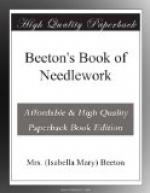[In working the following Embroidery Patterns it will be found advisable to trace the design clearly upon tracing-paper with a sharp-pointed lead pencil. The pattern thus traced must be perforated with a fine needle in a succession of tiny holes, at the rate of about twenty to the inch. Those ladies who possess a sewing-machine will find no difficulty in accomplishing this. Several thicknesses of paper can be perforated at the same time, if required, by any ordinary machine. To transfer the traced and perforated design to the fabric to be embroidered, it is only necessary to rub a small quantity of powder blue through the holes.]
131.—Insertion in Embroidery.
Material: Messrs. Walter Evans and Co.’s embroidery cotton No. 16.
This insertion is worked in raised satin stitch and button-hole stitch. The outlines must first be traced and the space filled up with chain stitches. To work a leaf, begin at the point, working from right to left, making short stitches, and always inserting the needle close above the outline and drawing it out below. The holes left for the ribbon to pass through are worked in plain button-hole stitch, the dots are worked in raised satin stitch.
[Illustration: 131.—Insertion in Embroidery.]
* * * * *
132.—Insertion in Embroidery and Stitching.
Materials: Messrs. Walter Evans and Co.’s embroidery cotton Nos. 10 and 16.
The veinings of this pretty insertion must be worked in overcast stitch (No. 68, Embroidery Instructions), the leaves and flowers in raised satin stitch, the scallops in button-hole stitch, and the outer edge of the leaves in back stitch (No. 70, Embroidery Instructions) with No. 10 cotton.
[Illustration: 132.—Insertion in Embroidery and Stitching.]
* * * * *
133.—Cravat End in Embroidery.
Materials: Muslin, cambric, or linen; Messrs. Walter Evans and Co.’s embroidery cotton No. 24, or fine black China silk.
This graceful design is worked in raised satin stitch (see Nos. 76 and 77, Embroidery Instructions) and back stitching, or point Russe. Black silk may be introduced at will, and the delicate leaves may be stitched in fine black silk, and the flowers embroidered in white, with the stamens in black silk.
[Illustration: 133.—Embroidered Pattern for Cravat Ends, &c.]
* * * * *
134.—Basket Embroidered in Chenille.
Materials: A basket of fine wicker-work; 1 skein of black chenille, and 3 of blue chenille.
This small round basket measures seven inches across; it has a cover and two handles. The wicker is very delicately plaited, and is ornamented with a pattern in chenille which is very easy to work. Upon the cover, work in point Russe one large star in blue chenille, with the centre and outer circle in black. All round, work small stars in blue chenille, with a black stitch in the centre. The position of these stars is shown in our illustration. The basket requires no mounting; it is not even lined.




